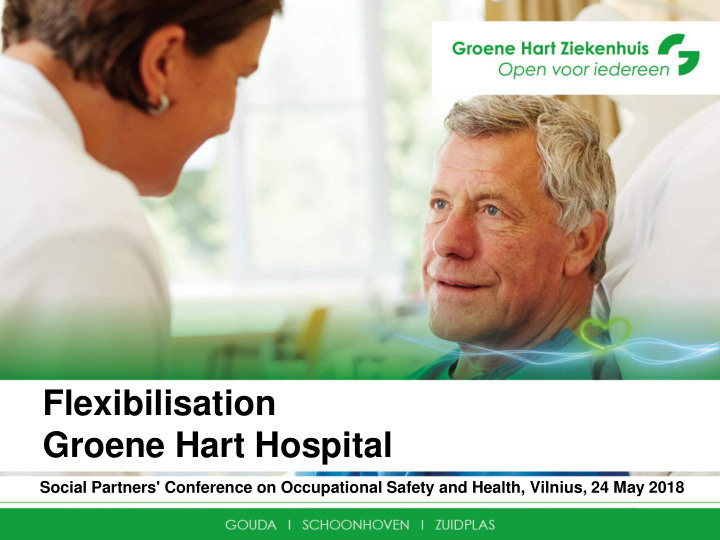



Flexibilisation Groene Hart Hospital Social Partners' Conference on Occupational Safety and Health, Vilnius, 24 May 2018
Contents • Who are we? • Groene Hart Hospital: key figures • Challenges • Flexibilisation of the nursing unit • Role of FIER • Experiences • New challenges • Take home message 2
WHO ARE WE? ELLES VAN DER NEUT & ELIZE HOOFTMAN 3
Who are we? Elles van der Neut • Nurse • FIER team leader Elize Hooftman • FIER manager, FIER line responsibility • Capacity managers: role in development, establishing integrated capacity management at Groene Hart Hospital, which includes flexibilisation. 4
GROENE HART HOSPITAL KEY FIGURES 5
Groene Hart Hospital: key figures • A general hospital by and for the Midden-Holland region (approx. 250,000 residents) • Over 2,000 employees 160 medical specialists • Turnover: € 202 million • 300 beds → 93,000 nursing days & 20,700 admissions • 300,000 outpatient clinic visits 6
CHALLENGES FOR GROENE HART HOSPITAL 7
Challenges • FTE savings • Reducing work pressure • Basic quality maintenance ------------------------------------------------------------------- + Flexibilisation of the nursing unit 8
FLEXIBILISATION NURSING WORKFORCE 9
What is 'flexibilisation of the nursing workforce'? • Permanent contracts vs. flex contracts; • Fixed term vs. indefinite period Ability to simply and rapidly scale up nursing services when demand for care increases (in terms of the number of patients or the intensity of care). 10
What are the guiding principles of flexibilisation? • Scheduling (based on patients and patient patterns, rather than beds) and making adjustments based on expected number of patients; • The nursing capacity is based on pre-determined standards. 11
How do we organise flexibilisation? The difference between a standard and a specialist in-patient ward Standard wards (surgery, internal): • Lower number of basic workforce, higher flexible non-core workforce (from FIER) Specialist wards (IC, paediatric ward, obstetrics): • Individual wards arrange their own flexible non-core workforce, on the condition that any 'overcapacity' is deployed internally. No intervention by FIER. The daily capacity meeting is the most important method for implementing and determining the aforementioned tasks on a daily basis. 12
ROLE OF FIER WITH REGARD TO FLEXIBILISATION 13
Role of FIER • FIER provides the flexible non-core workforce for the standard in-patient wards. • Flexbureau vs. FIER From filling in staff shortages to scaling up in the event of a greater demand for care • Flexibly employable and (&) Results- oriented (‘proud') 14
Groene Hart Hospital – organisation chart 15
FIER's flexible non-core workforce • There are clusters of (standard) in-patient wards: a max. of 3 wards per cluster. • Flexible nurses are taken on board, deployed and trained within this cluster; • The level of knowledge is geared to the relevant ward; • Flexible nurses are scheduled for shifts based on the cluster's patient patterns ; • The day prior to the shift the final decision is made regarding the ward where the nurse will be deployed. 16
It was not (and still is not) always easy... • Staff scheduling is a true profession! • Stable and effective staff scheduling is essential. Knowledge and expertise in this area is sometimes insufficient. • Introducing a new manner of working into an existing situation is no simple matter. • Change provokes resistance... 17
but it has also benefited us greatly! • Wards are increasingly looking beyond the confines of their own walls. • A close collaboration between FIER and wards facilitates short lines of communication and enables us to key into the situation more quickly. • Flexible nurses are given additional opportunities to further their professional development. • A first step in standardising work processes, which raises the quality of care • Roughly 5% in savings on the nursing workforce 18
EXPERIENCES BY ELLES, FLEXIBLE NURSE 19
Experiences • To be completed by Elles 20
New challenges • Scarcity of nurses - basic schedules not in order • Scheduling is decentralised and insufficiently coordinated; • Scheduling is decentralised, making close collaboration labour-intensive; • The nursing standard and, as a result, the work pressure is high (currently impossible to measure) • Further standardisation 21
Take home message • Collaboration/ working together is necessary • Not every nurse likes to work in multiple wards so find the right people for this job • Find a way to properly match supply and demand, flexibilisation is one way – Scheduling is a profession 22
Recommend
More recommend